1lumen selects and reviews products personally. We may earn affiliate commissions through our links, which help support our testing.
Fenix TK16 V2.0 review
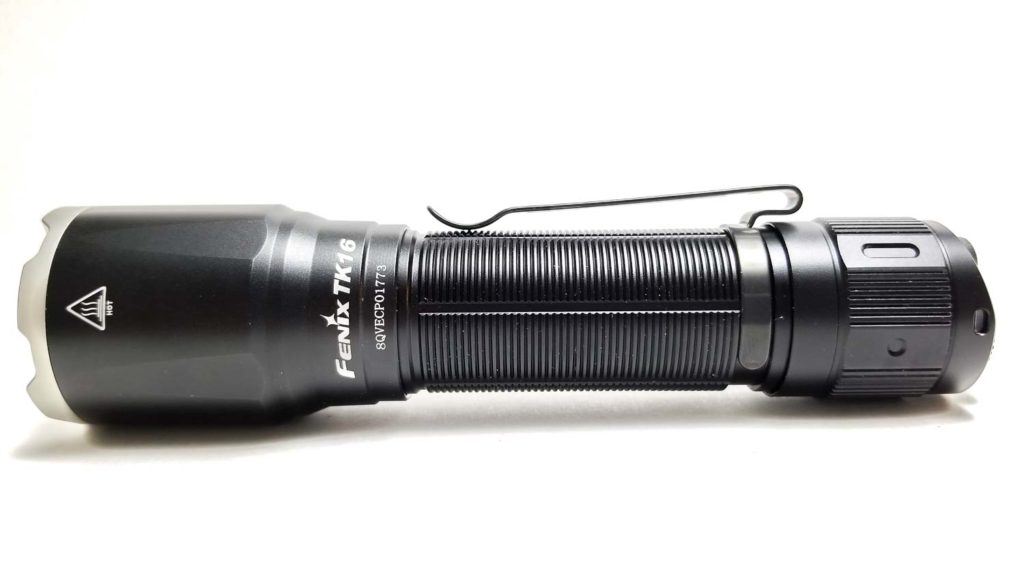
Fenix TK16 V2.0 specifications
| Brand/model | Fenix TK16 V2.0 |
|---|---|
| Category | Tactical Flashlight |
| LED | Luminus SST70 |
| Lumens | 3,100 lm |
| Beam intensity | 31,600 cd |
| Battery config. | 1*21700 |
| Material | Aluminum |
| Modes | 5 |
| Blinkies | Single multi-strobe |
| Reflector | Smooth |
| Waterproof | IP68 |
| Review date | April 2021 |
Introduction:
When I think of a tactical flashlight I picture a blacked-out light with a grip ring and gnarly strike bezel accompanied by guns ‘n’ gloves. Obviously, that’s a very generalistic description, but not all “tactical” flashlights are tactical flashlights. Some are just regular lights with “tactical” stuck on the name sporting gimmicky, useless, features. The tactical flashlight market is pretty crowded and full of some pretty terrible posers. However, some manufacturers stand out as making bonafide tactical lights, with functional strike bezels, heavy-duty finishes and construction, tactical grip rings, forward tail switches, simple UI’s, and features conducive to mounting on firearms (remote switches, etc.). One is Fenix. They have been in the flashlight business since 2001, and make some nice professional-grade lights. Today I will be taking a look at something new (or old) from Fenix, the TK16 V2.0. As the name implies, this is the refreshed version of the venerable TK16 tactical flashlight first introduced in 2015. The TK-series is marketed to law enforcement, military, first responders, and other professionals. The new version has some very nice upgrades and greatly improved performance. Let’s see if Fenix has once again made a true-to-form tactical light.
Package quality.
I consider Fenix to be a premium brand, so I naturally expect premium packaging, and that’s about what you get, a nice box with a hang tag meant for retail sales. The presentation is very Acebeam-like and well-executed with a picture of the light up front, plastered with easy-to-read font and lots of product highlights. On the back, There’s a comprehensive list of vital specs and features. Inside the box is an equally impressive assortment of accessories:
- Fenix TK16 V2.0 flashlight
- Fenix ARB-L21-5000U 21700 battery
- 2 spare o-rings
- Lanyard
- User manual
- Warranty card
- Marketing insert
- USB type C charging cable
- Holster
I’m always impressed when flashlight manufacturers don’t skimp or cheap out on accessories, and Fenix gives you absolutely everything needed to turn the light on and go. No issues with quality, but the USB cable seemed cheap (and short at 12 inches). The lanyard was the non-adjustable cheap type, but seemed sturdy, and the holster seemed well-made also.
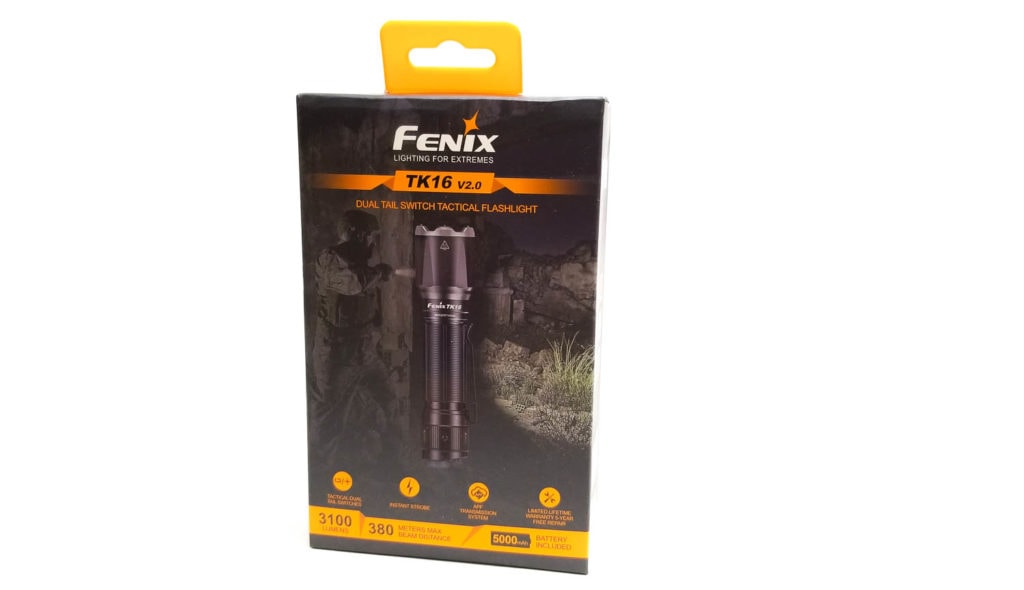
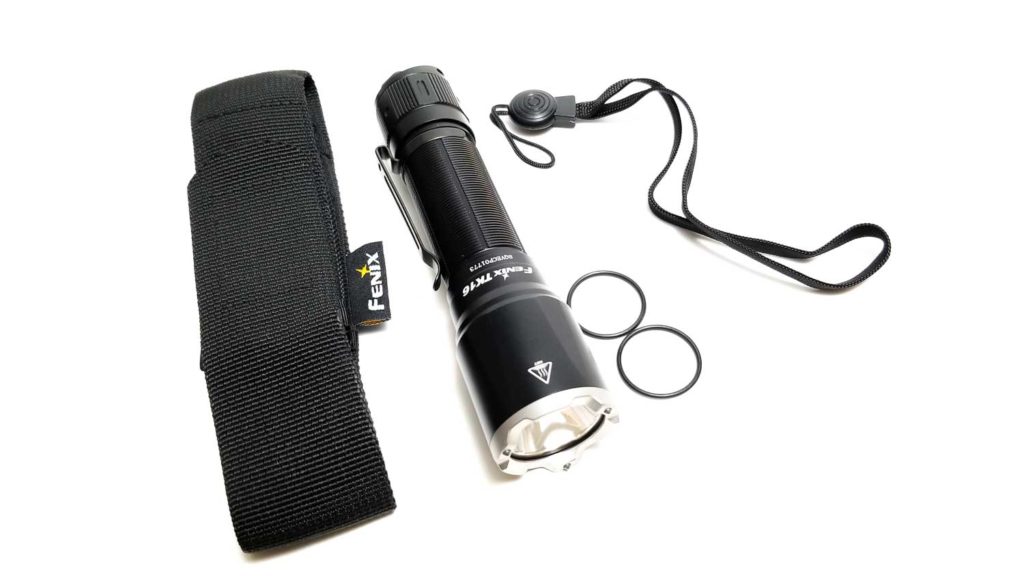
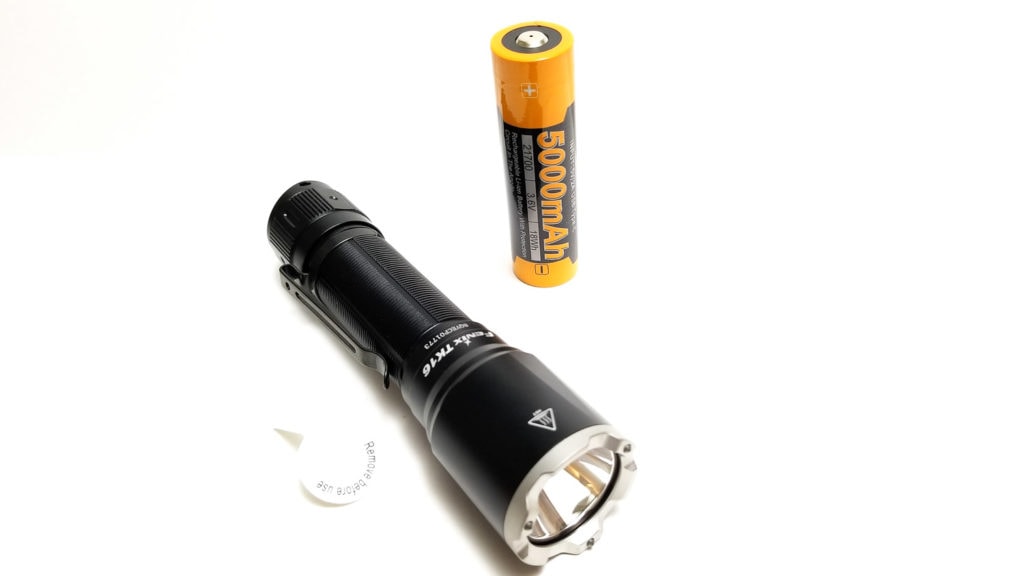
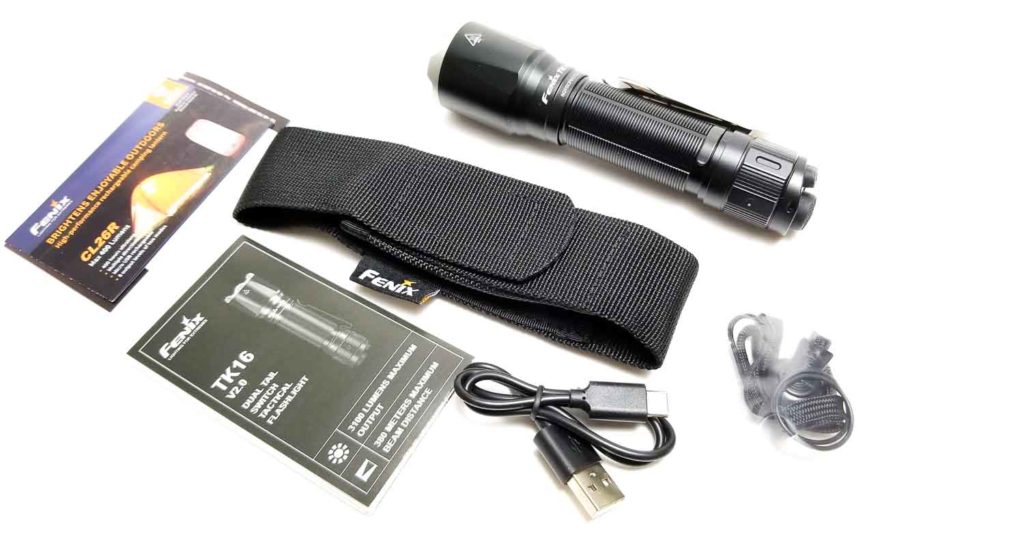
Flashlight in use
Being a 21700 size light, it naturally feels great in the hand, and I didn’t experience anything anomalous when handling the light. I was surprised by how light it is for a 21700-size flashlight, which contributed to easy handling. All the UI functions are managed via 2 tail-mounted switches. One is a traditional forward clicky, and there’s a secondary, smaller momentary e-switch above it that’s used to change modes and activate the strobe function. The switches are well-positioned for natural manipulation with the thumb, and with a little practice, I could use the pad of my thumb to manipulate both switches. The switches have solid, snappy click action and didn’t feel mushy or vague.
There’s no knurling on the light, but the battery tube has grooves machined into it in a pattern known as reeding, which is found on a lot of Fenix lights. These actually give a good amount of grip and traction. The pocket clip is reasonably sturdy and has great tension. In addition, the clip is removable and reversible so you can carry the light bezel up or down. In addition, the tube is also reversible. The holster has a sturdy Velcro cover, and could easily be mounted to a duty belt. It also allows bezel up or down carry, and the light was surprisingly easy to extract from the holster. There’s a pair of lanyard holes 90 degrees opposite each other in the tail. Unfortunately, tail standing is not possible with the TK16 V2.0 as the dual tail switches get in the way.
Commensurate with professional lights, Fenix sells a very comprehensive assortment of optional accessories for the TK16, including firearm mounts, remote pressure switches, a wand for traffic control, a bike mount, diffuser tip, quick-detach duty belt clip, quick release duty holster, and no less than three 21700 batteries.
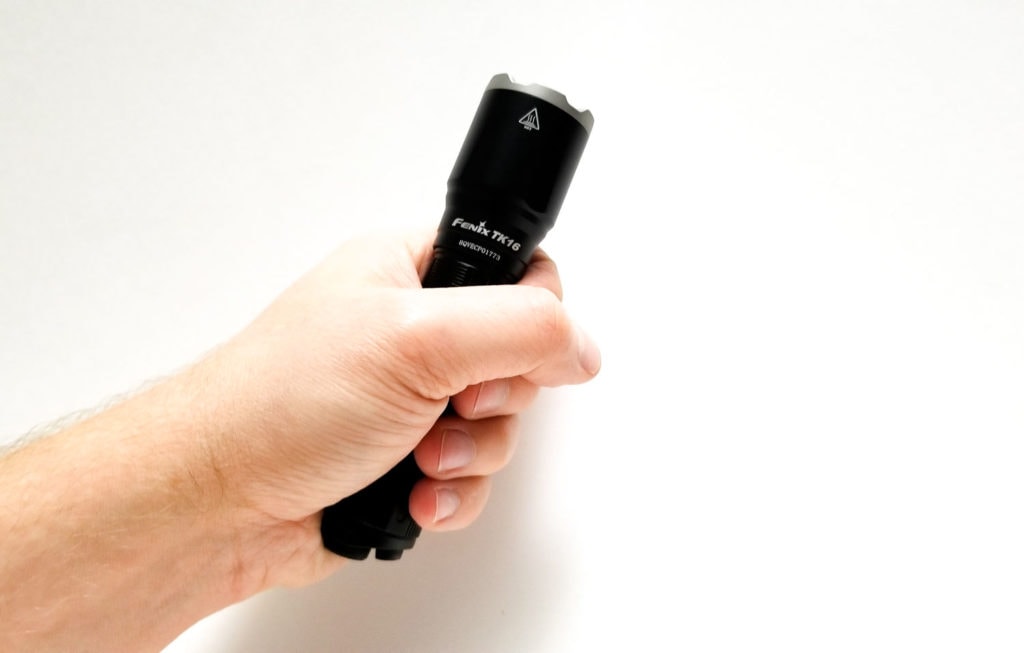
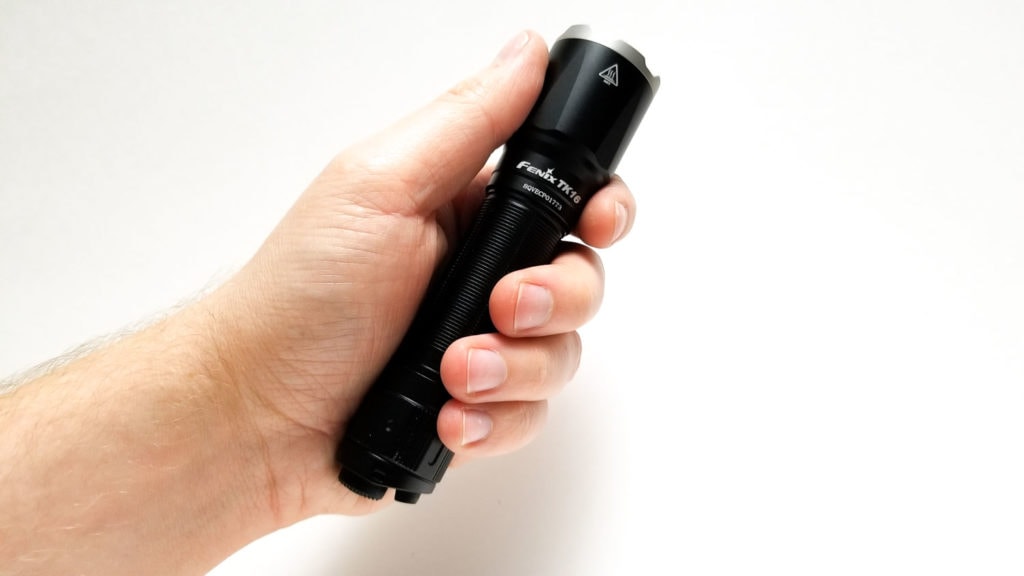
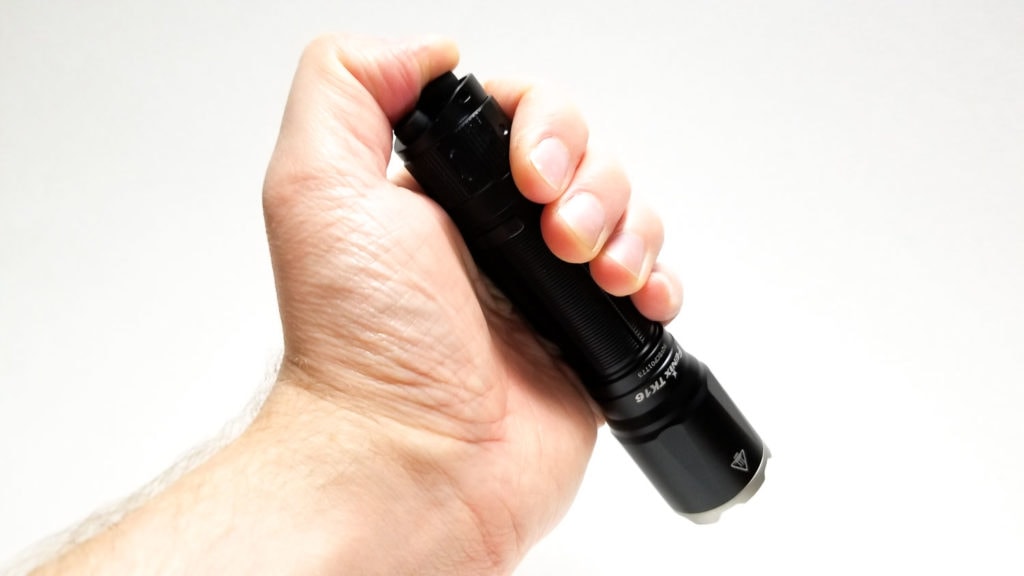
Build Quality, and Warranty
This is my first Fenix flashlight review, but right away, I could tell it’s a quality item. Fit and finish are excellent, and the machining is absolutely flawless with no chips, burrs, or machine marks. Nothing rattles around, and all the parts fit perfectly with no gaps.
The light is made from tough 6061-T6 aluminum alloy with deep black type III HA anodizing. The finish is more glossy than matte, and of course it’s flawless with no thin spots or blemishes. It’s durable too, and didn’t show noticeable wear even after removing and rotating the pocket clip around. I have no doubt this light will hold up to some hard use and abuse. The silkscreening is also super sharp. It’s that attention to details that really sets the quality bar pretty high.
The light breaks down into three parts: head, battery tube, and tailcap. I tried unscrewing the bezel with my hands, but it’s either glued or Loctited. Aside from the battery, there’s no user-serviceable parts on this light. For ingress protection, Fenix rates the TK16 V2.0 at IP68, specifying total dust-tightness and able to withstand complete, continuous submersion in water at depths of 1 meter or more.
The bezel, front, and rear of the battery tube are sealed by a single good-sized o-ring and the threads are perfectly square cut and fully anodized, so you can manually lock out the light. They weren’t the smoothest I’ve felt despite being lubricated, so I think Fenix could have improved the smoothness with a bit more lube. I added some SuperLube and voila, smooth like butter.
The spring on the driver side and tailcap are short, thick, gold-plated units and look to be high quality. Durable tailsprings here are important because the Fenix TK16 V2.0 can be mounted to a rifle and springs absorb recoil energy and prevent the battery from rebounding off the contacts causing connection breaks or damage. Interestingly there’s no inner sleeve in the battery tube like on some rear e-switch/clicky lights, and I like this because it’s one less potential failure point and helps with durability. The magic must happen inside the tailcap on a PCB, which I suspect would create an interesting current path (more on that later).
Fenix’s commitment to quality extends into the warranty. They offer a 15-day no questions asked replacement for factory defects, with a limited lifetime warranty with free repairs and labor for 5 years. After 5 years, Fenix will repair the light free of charge, but you are responsible for any parts. Fenix also extends the warranty 6 months for registering the product, which is nice. Fenix batteries are warrantied for 1 year.
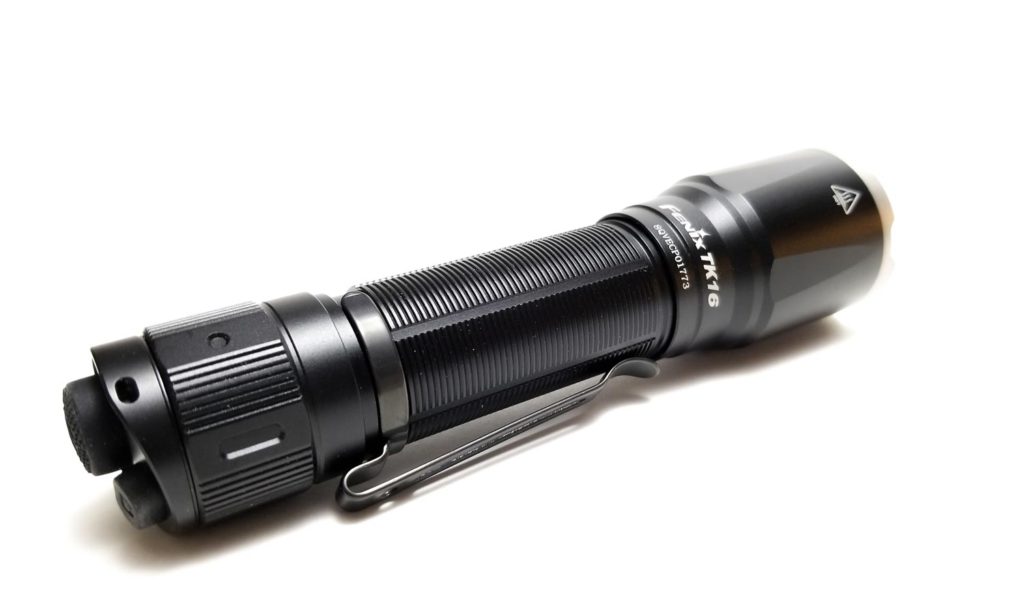
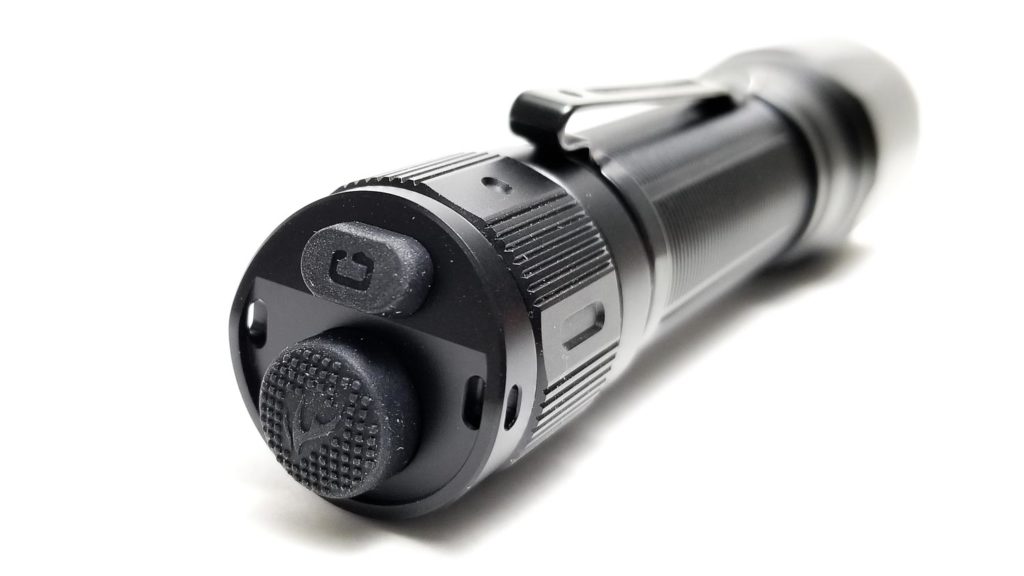
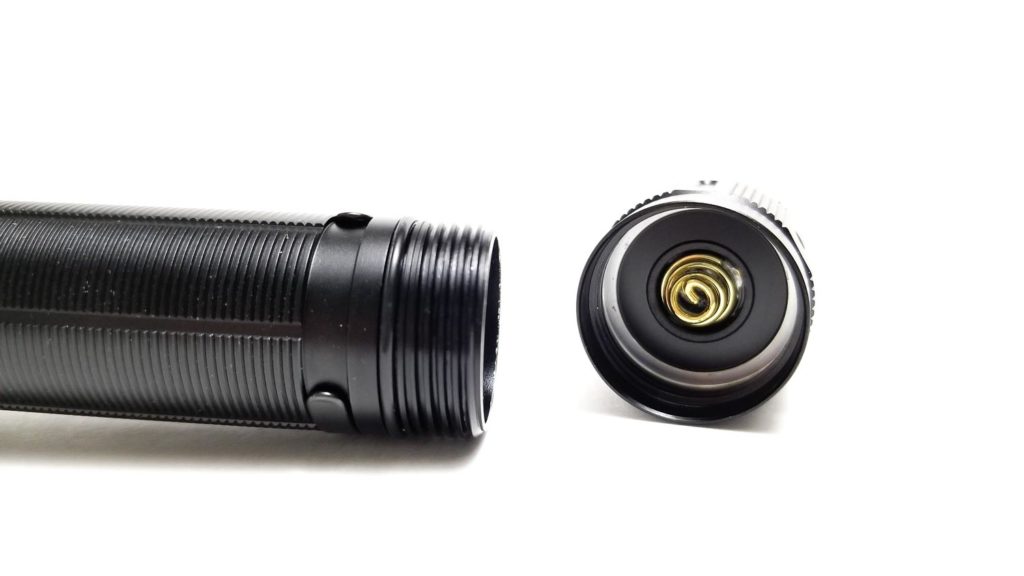
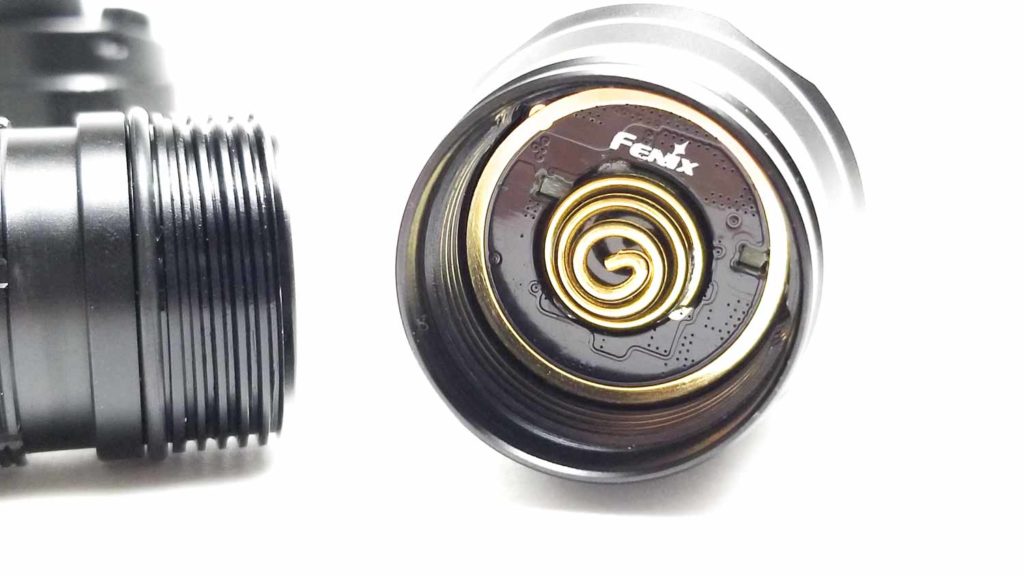
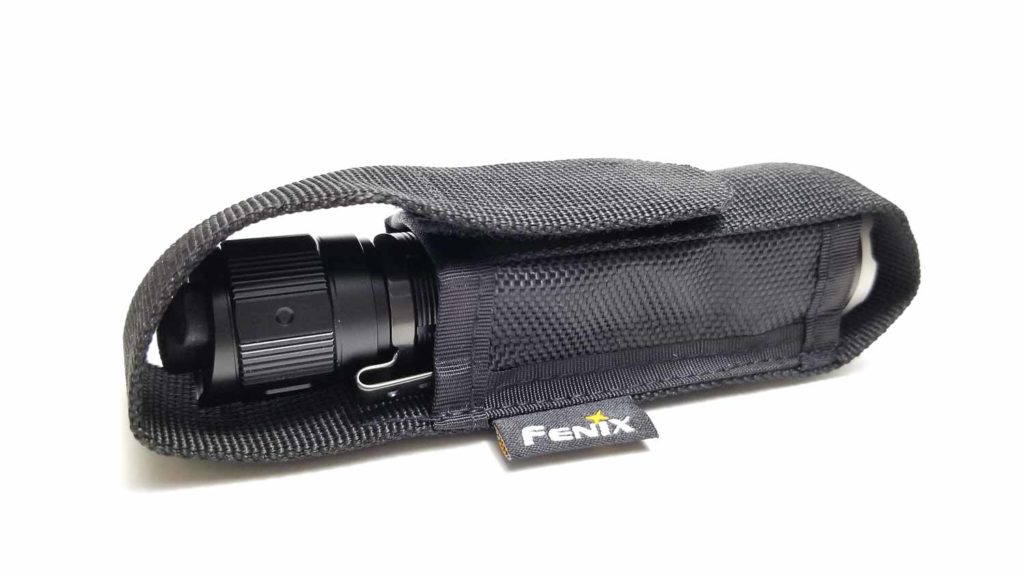
LED, Lens, Bezel, and Reflector
I always appreciate a manufacturer that doesn’t try to hide the LED they use behind ambiguous marketing nonsense. Fenix could have gone the popular route and stuck in an XHP50.2 for maximum output, but they went one better with the Luminus SST70 in cool white (I estimate 6000K). I’m glad they did. The SST70 is a 6 or 12 volt quad-die emitter like the 50.2, and shares the same dimensions. However, the SST70 has a light emitting surface 55 to 60% smaller than the XHP50.2. This means you get more throw at similar output with better tint, and a cleaner, more uniform beam.
The SST70 sits perfectly centered in a deep flawless SMO reflector and AR-coated mineral glass lens. The bezel is pretty substantial for a small light. It’s sandblast-finish stainless steel with obligatory crenulations, but 3 of the crenulations contain pointed tungsten carbide breaking tips that stick out about 1 mm. They look pretty gnarly and would be perfect for breaking a car window, protecting the lens, or in a self-defense situation. I’m obviously not going to break out my car’s window to test this, but I have no reservation that it could do it.
The SMO reflector gives the TK16 V2.0 good throw and very generous spill and good side illumination. You also get a nice tight hotspot, and combined with the well-spaced modes, I think this is perfect for tactical work as well as general purpose. There’s no obvious tint shift and minimal corona. Yes, the beam is a bit green at low outputs, but mostly goes away pretty quickly with increased brightness and is really only annoying if hunting suspects against white walls.
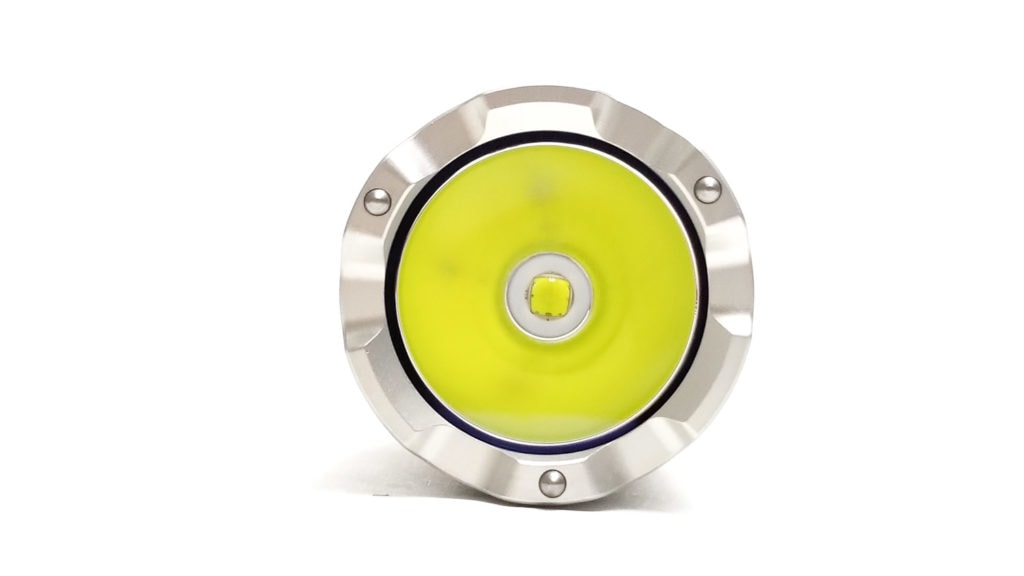
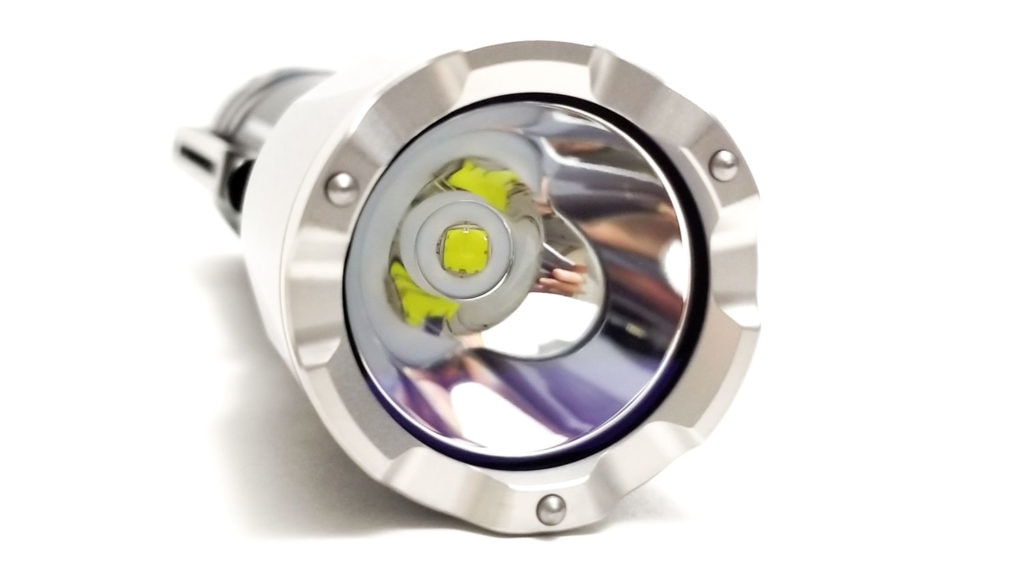
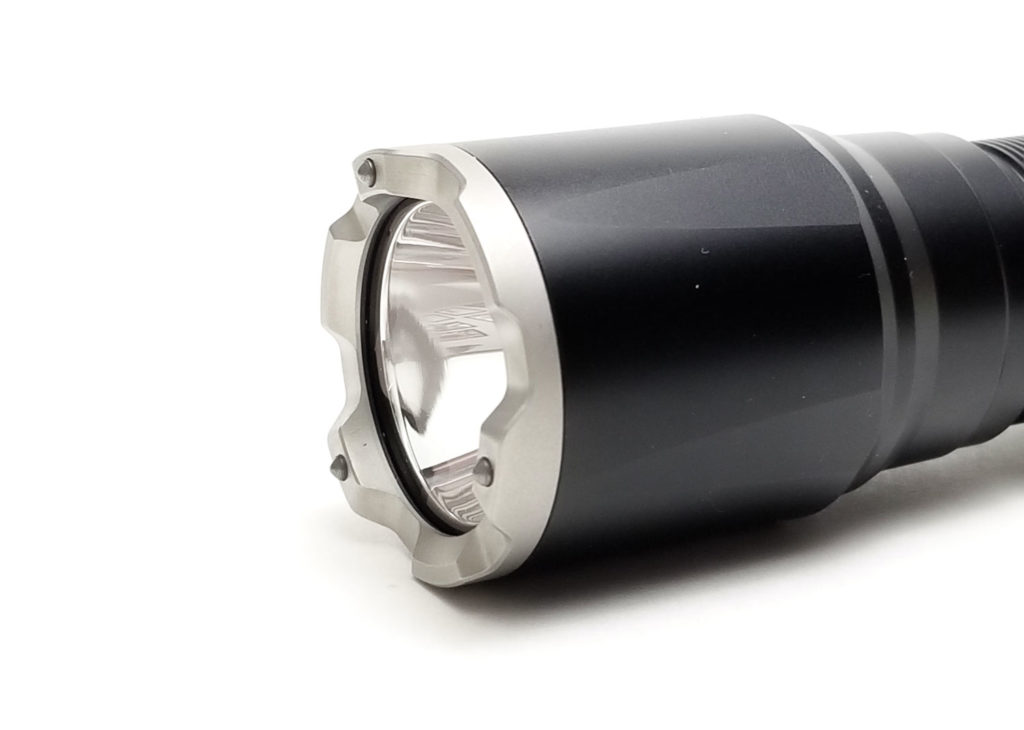
Dimensions and size comparison
- Length: 14.3 cm / 5.63 inches
- Head diameter: 3.4 cm / 1.34 inches
- Body diameter: 2.5 cm /1.0 inches
Weight:
- With Fenix ARB-L21-5000U 21700: 185 grams / 6.52 oz.
- Without battery: 112 grams / 3.95 oz.
Flashlight size comparison
Compared to other popular flashlights
Group 1 (left to right): 3D Maglite, Fenix TK16 V2.0.
Group 2 (left to right): Thorfire C8, Fenix TK16. V2.0. Group 3: Acebeam L17, Olight Odin Mini, Fenix TK16 V2.0, Acebeam L19.
You might be asking why I included a Maglite? Yes, it’s old and antiquated by today’s standards, but the Maglite sort of represents the genesis of tactical flashlights. Security personnel, law enforcement officers (my Dad carried one), firefighters, paramedics, and other professionals have used (and abused) Maglites for decades. Plus it really gives a good idea of how far flashlights have come in terms of size!
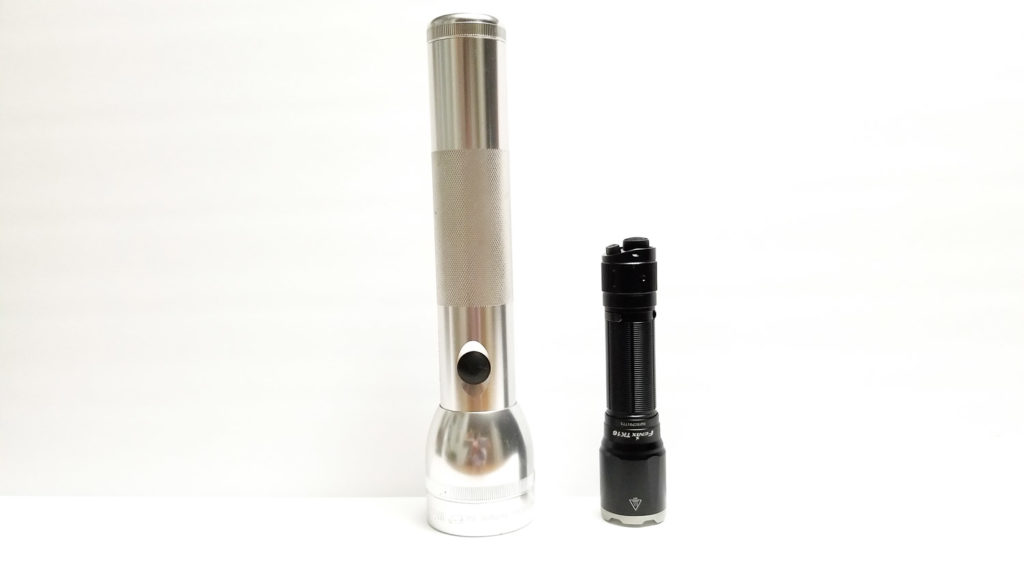

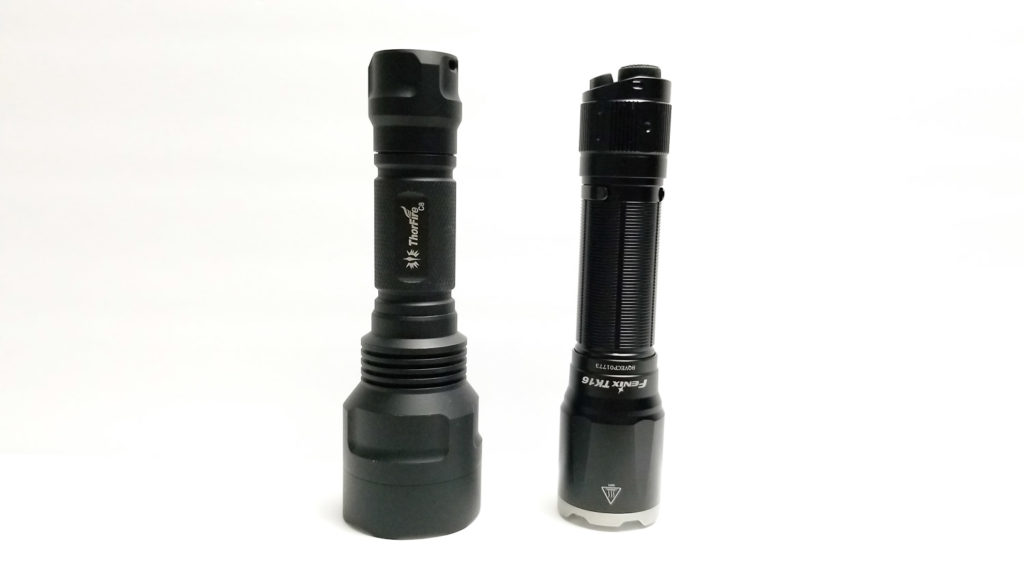
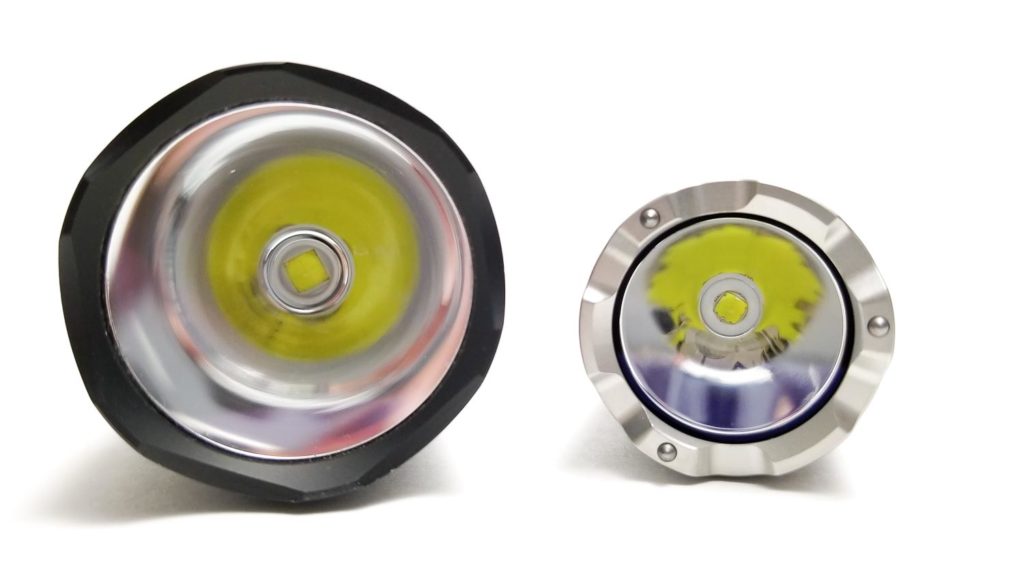
Driver & User Interface:
The driver in the Fenix TK16 V2.0 is glued inside the head so I can’t take a look at it, but it’s going to be a constant current boost driver to step up the 4.2 volts from the battery to 6 volts for the SST70. For the UI, you won’t find Anduril, Biscotti, or Narsil on here because professionals won’t be bothered with multiple menus, ramp configuration, or thermal calibration, and could care less about fancy blinky modes. They just expect the light to turn on when they push the button.
The UI is 5 modes and a single variable strobe that is very effective (disorientating). The main (large button) is a true forward clicky switch that turns the light on as soon as you press it, unlike a reverse clicky that requires a full press and release to turn on. The forward switch turns the light on and off and allows for signaling, while the secondary switch is for accessing strobe and for mode changes when the forward switch is activated. It does have mode memory, which is a bit controversial since in tactical situations because you may not want your light going to turbo or eco and vice/versa when you turn it on.
Modes: Eco, low, medium, high, turbo. Strobe is accessed only through the secondary switch and is not part of the regular modes.
From OFF:
- Press and hold main forward click switch: Momentary or continuous operation in last memorized mode
- Single-click: Turns off
- Double click: N/A
- Press and hold secondary switch: Strobe mode
From ON:
- Press and hold main forward switch: N/A
- Press and hold secondary switch: Strobe mode
- Single click main switch: Turns off
- Single click secondary switch: Switch modes (eco-low-medium-high-turbo).
- Double click: N/A
Mode memory:
- Yes, last mode memory
Low voltage warning:
- Yes, the light will gradually shift to eco mode and blink 3 times each for 5 minutes as a visual LVP reminder until the light shifts to a very low mode and runs until it turns off.
Strobe/blinkies
- Single variable strobe, accessed via the secondary switch.
Lock-out mode:
- None. Unscrew the tailcap ⅛ turn to manually lock out.
PWM
- Yes, only in low mode, but not visible to the naked eye.
Additional info: Although some purists will scoff at anything over 2 modes with memory on a pure tactical light (like Olight’s UI), I think the TK16 has a well-thought-out and executed UI that works great with the dual switch configuration. This is more than ‘tactical’ enough for law enforcement, security, and other duties and is easy to use. I don’t think you would hear anyone say, “how do I turn it on?” Just push the big button to turn it on, and touch the little one to change modes. Easy peasy. I like how the strobe is not part of the regular modes and can be called up with a single button press. Fenix also advertises a feature called Advanced Pulse Frequency Transmission System. They don’t list any information on it aside from a short blurb about anti-interference and better performance. Maybe it has to do with eliminating a separate transmission tube for the clicky/e-switch functions? I could hear a very faint clicking noise from the tailcap when the strobe was running if held up to my ear, so maybe there’s a MOSFET or some other transistor handling the switching? The driver works fine, and I didn’t experience any issues with flickering or loose connections even when jostled around quite vigorously. There’s no electronic lockout, and that’s important because if you forget you locked your light and need it to turn on, this could be very bad in a ‘professional’ situation.
Batteries & Charging
The Fenix TK16 V2.0 takes a 21700 size lithium ion battery and comes with the Fenix ARB-L21-5000U 21700. It’s a 5000 mAh (18 Wh) battery with built-in USB type-C charging and a protection circuit. It came charged to 3.6 volts, which is optimal for storage. It was preloaded in the light with a plastic isolator to break the electrical connection.
Okay, I know professionals probably won’t care about this, but I think it’s worth mentioning. Some of the mainstream pro-grade lights are designed around proprietary batteries, and while that’s not a terrible thing, it puts off some buyers. However, you can use any 21700 you want in the TK16 V2.0, but there’s a caveat: they must be button tops or protected. I tried a flat top Samsung 30T and it was too short, but my protected Acebeam button top and a non-protected Epoch brand (rewrapped Samsung 50G) button top worked just fine. Thanks Fenix!
The charging is rated at 5 volts 2 amps, and when I tested this with my Hidance USB meter I got 1.47 to 1.50 amps. Not exactly fast charging for a high capacity cell. There’s a tiny hole in the center of the button top that houses an LED indicator for charge status: Red for charging and green for fully charged. Attention manufacturers: Can we please get blue LED charge indicators? The cell was charged to 4.19 volts per my DMM.
My charger won’t fit cells this long, so I don’t know if you can charge it that way, but I would imagine you can.
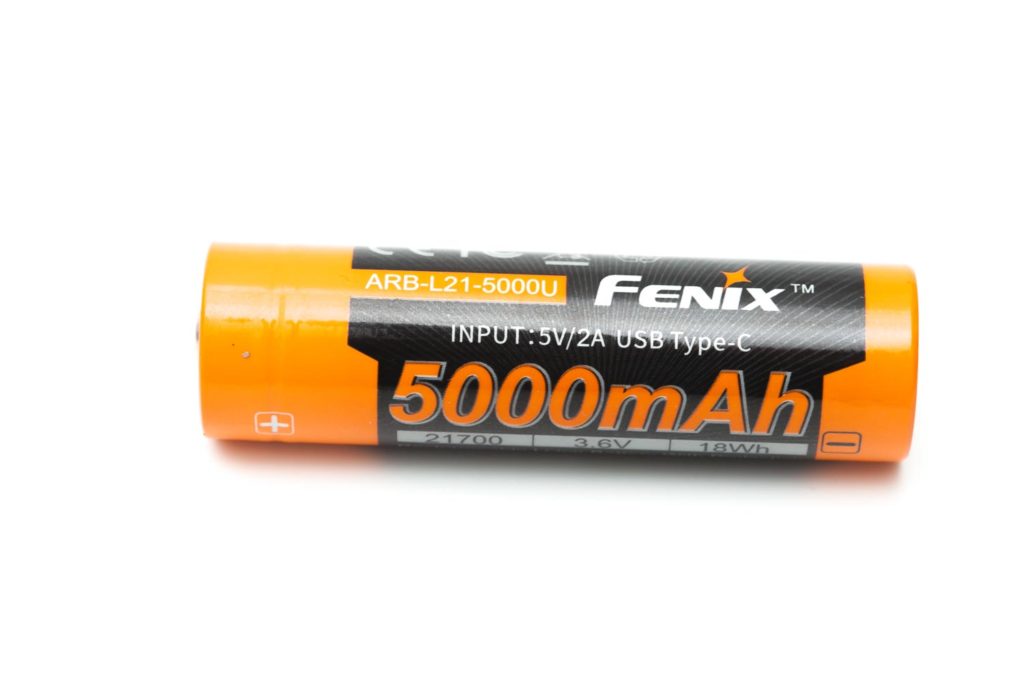
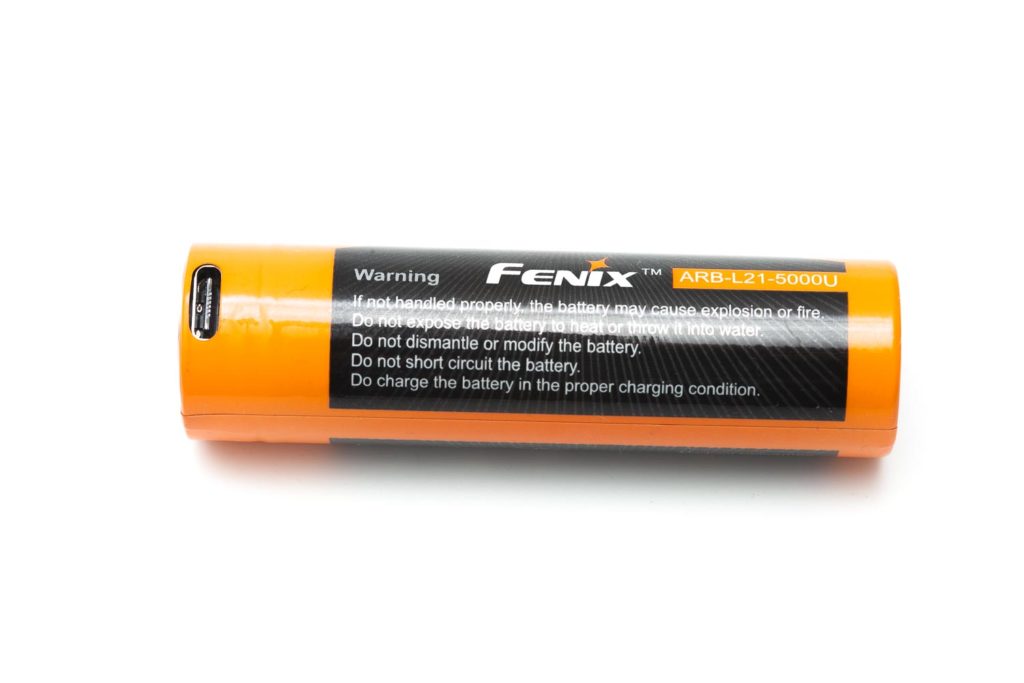

Performance
If Fenix’s specs are true, the V2.0 is a huge step up in performance over the first TK16, which managed 1,000 lumens.
Amp measurement
I wasn’t able to get a full measurement of the current draw due to the design of the tailcap. I discovered this when I measured for parasitic draw in the normal way, it came up with battery voltage. Hmmm. When I measured for continuity at the switch, there wasn’t any, just an open circuit. This tells me the current path is inside the tailcap, and getting to it would mean potential destructive disassembly.
I was only able to get one measurement from the tailcap in the traditional way using my clamp meter with a short piece of 12 gauge wire in a loop. The one measurement I did get was 2 amps, but I don’t know if it was part of the modes because it was too bright for medium and high, but not bright enough for turbo.
Parasitic drain:
I was unable to measure the parasitic drain due to the design of the tailcap.
Runtime graph
I conducted the runtime test using the 30 centimeter integrating sphere with the Digi-Sense 20250-00 data logging lux meter. I used the fully charged ARB-L21-5000U battery and tested all modes (except strobe). To be honest, this is by far the most boring (read: long) runtime tests I’ve ever done. Maybe a little more entertaining than watching paint dry or grass grow, but not nearly as exciting as waiting for water to boil.
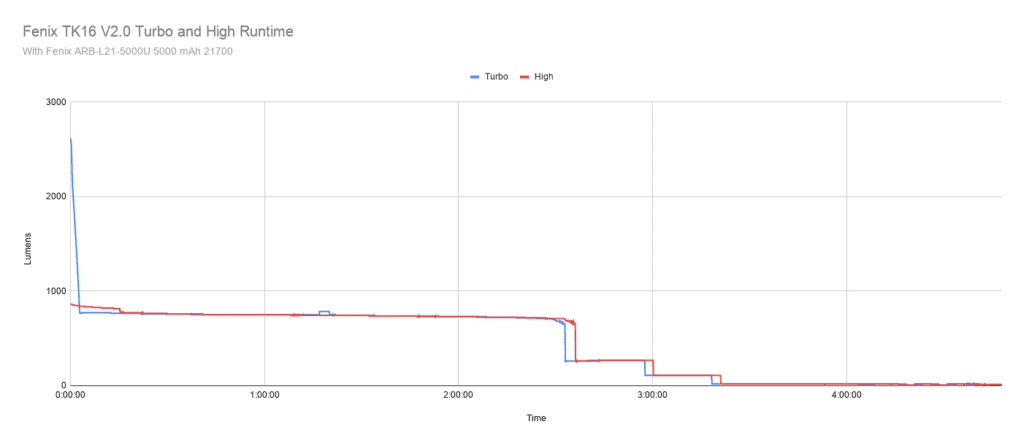
Starting with turbo, the test started at 2662 lumens and within 20 seconds was under 2500 lumens. It did heat up fast, and the head temperature at 60 seconds was 45.3 C (from 23 C ambient), and that went up to 51.2 C in another 30 seconds. I never saw over 54 C at the head, so the Fenix TK16 V2.0 could be handheld even during extended turbo runs. The light held about 1000 lumens for over 2 minutes, eventually settling at about 700 lumens. It wasn’t until 2 hours 33 minutes that it throttled back to under 300 lumens. The last step down was down to 6.9 lumens before the light shut off at the 4 hour 47-minute mark. They don’t show up well on the graphs, but there are blips towards the end from the LVP notifications, flashing every 5 minutes or so until the light turns off.
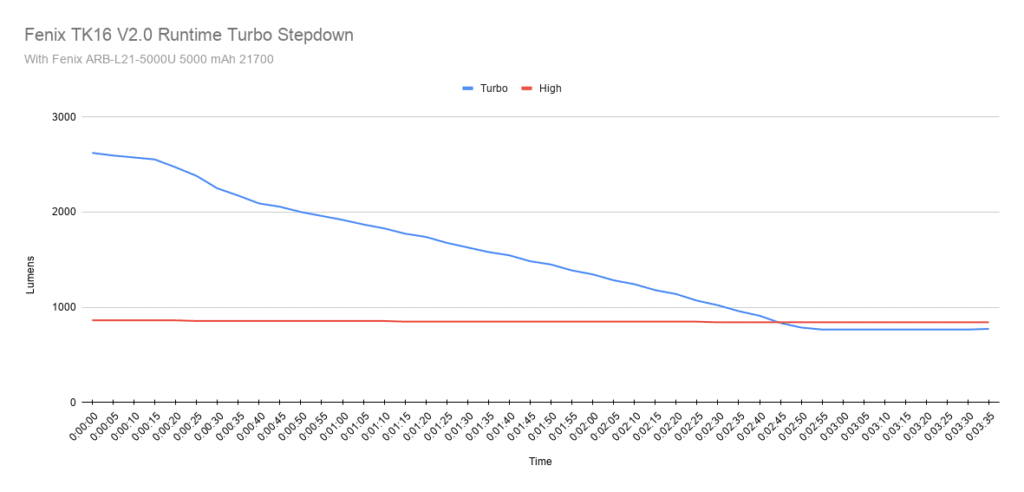
High was very similar to turbo, albeit with reduced output. Starting out slightly under 900 lumens, the light held over 800 lumens for 15 minutes before stepping down gradually over the next 4 hours. Turbo and high were mirror images starting at the 2 hour, 36 minute mark with high shutting down 4 minutes after turbo at 4 hours 51 minutes.
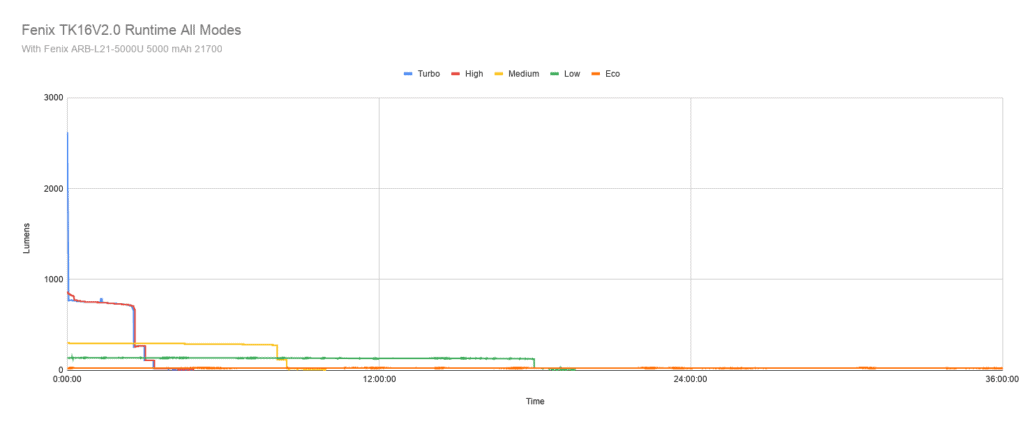
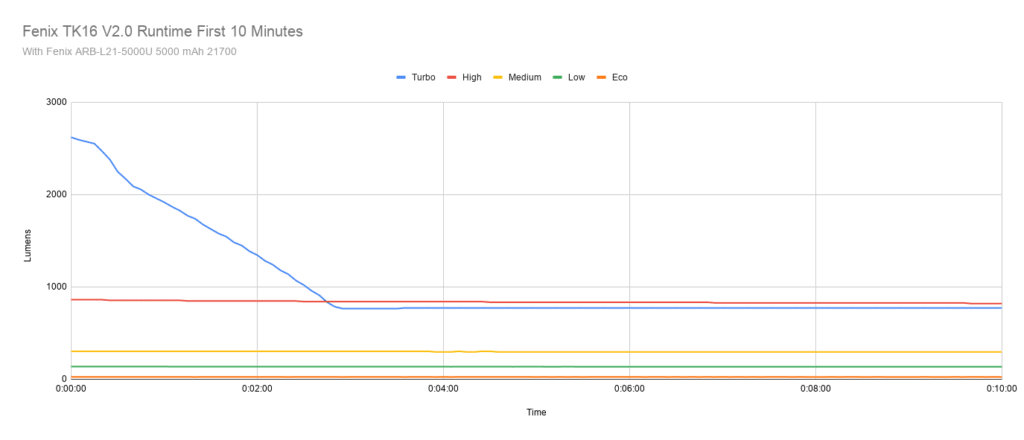
Medium, low and eco were the most boring of the tests, For medium, starting at 303 lumens down to a hair over 13 lumens took 9 hours, 56 minutes, with the same LVP indications as the other runtimes towards the end starting at the 9 hour, 11 minute mark until shutdown. Low started at 138 lumens and held over 130 lumens for over 16 hours. Impressive! Total time was nearly 20 hours straight at 19 hours 32 minutes. Eco was the marathon winner in this test for sure, and I gave up before it did. Output was rock-steady at about 25 lumens until I pulled the plug at 36 hours.
Takeaways? This is another area where quality and attention to detail are evident. The boost driver is well regulated and seems to be very efficient and a good fit for the SST70 LED. It’s apparent Fenix stayed conservative with the thermal regulation at under 55 C, which is very well executed with no erratic or anomalous fluctuations. The brightness is also well regulated and stays consistent. I think Fenix did a great job designing this light for consistent output during continuous operation. This would be perfect for sticking on a diffuser cone and directing vehicle or foot traffic for 8 hours a day, or in the hands of a police or security officer who needs a light to last for the full 10-12 hour graveyard shift.
Lumen measurements (for each mode)
For the lumen tests, I used my homemade 30 cm integrating sphere calibrated with a light of known output using the Digi-Sense 20250-00 data logging lux meter. I used the included fully charged ARB-L21-5000U battery. Readings were taken at 30 seconds. I captured the turn-on reading for turbo and high since the output drops so quickly.
| Mode | Measured Lumens | Advertised Lumens |
| Eco | 26.22 | 30 |
| Low | 138 | 150 |
| Medium | 303.6 | 350 |
| High | 848.7 (855.6 at start) | 1000 |
| Turbo | 2221.8 (2656.5 at start) | 3100 |
My numbers are a little down from the Fenix advertised. It’s possible the bezel is blocking some light from getting to the lux meter sensor. Still, these are pretty impressive numbers for a single LED, and higher than any SST40 or XP-L2 could manage on the top end.
I re-ran the lumen test a week after I did the initial measurements. Once the battery had been discharged and recharged several times (for the runtime tests), I noticed the lumen numbers went up a bit: Eco 28.98, low 146.28, medium 317.40, high, 910.80 at turn on, and turbo 2760 at turn on. A little better, but still on the low end for turbo.
Throw numbers:
The throw was measured at 5 meters indoors using the Uni-T UT383S lux meter. I used the fully charged ARB-L21-5000U battery for all tests. All readings were recorded at 30 seconds.
| Mode | Measured Throw | Advertised Throw |
|---|---|---|
| Eco | 325 cd, 36 meters | 330 cd, 40 meters |
| Low | 1,850 cd, 86 meters | 1650 cd, 80 meters |
| Medium | 4,375 cd, 132 meters | 3900 cd, 125 meters |
| High | 12,800 cd, 226 meters | 12,000 cd, 220 meters |
| Turbo | 40,900 cd, 404 meters | 31,600 cd, 380 meters |
I’m very impressed with the throw numbers, and I beat the Fenix advertised figures. The SST70 really has excellent throw out of the TK16’s relatively small reflector, and is a good example of why I really like this LED.
Beamshots
I compared the TK16 V2.0 to another true tactical light, the Olight Odin, which has a neutral white emitter behind a TIR optic designed for closer range and optimal side illumination, and a modified C8 with an FET-driven 5000K SST40 and SMO reflector. I used turbo (high on the Odin since it’s 2 modes only). Camera settings are the same.
- Outdoor shots: The fence is about 95 meters away. We can see the C8 is the obvious throw winner, followed by the TK16. The Odin is meant for shorter ranges, not throw, and that shows.
- Indoor shots: The end of the hallway is about 10 meters (32 feet). This is where the Odin really shines (no pun intended) with the diffuse spill and defined hotspot, great for shorter ranges. The C8 shows the limitations of a quasi-thrower at short range, while TK16 V2.0 has good side illumination, tight hotspot, and more than enough throw for general purpose work.
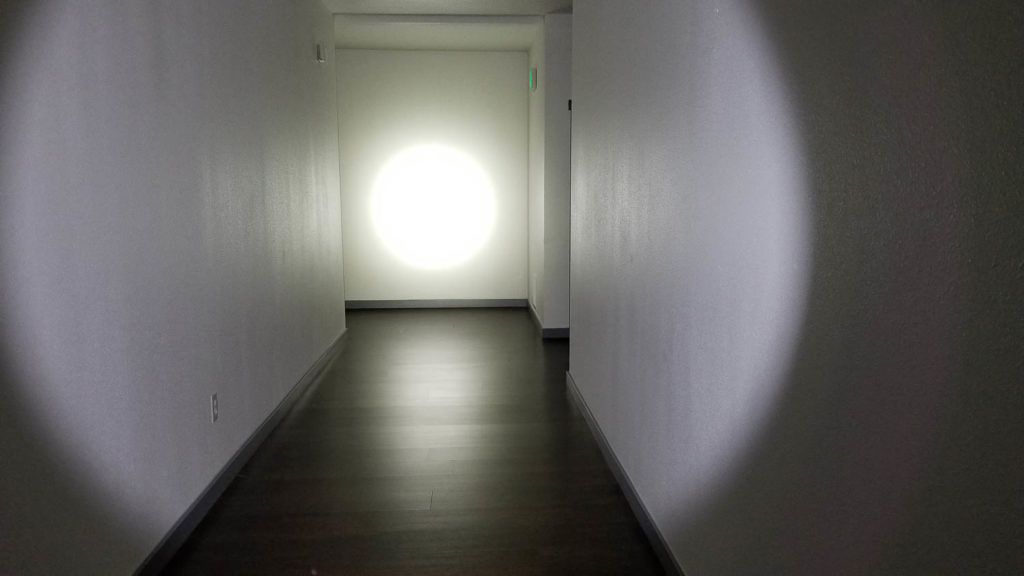

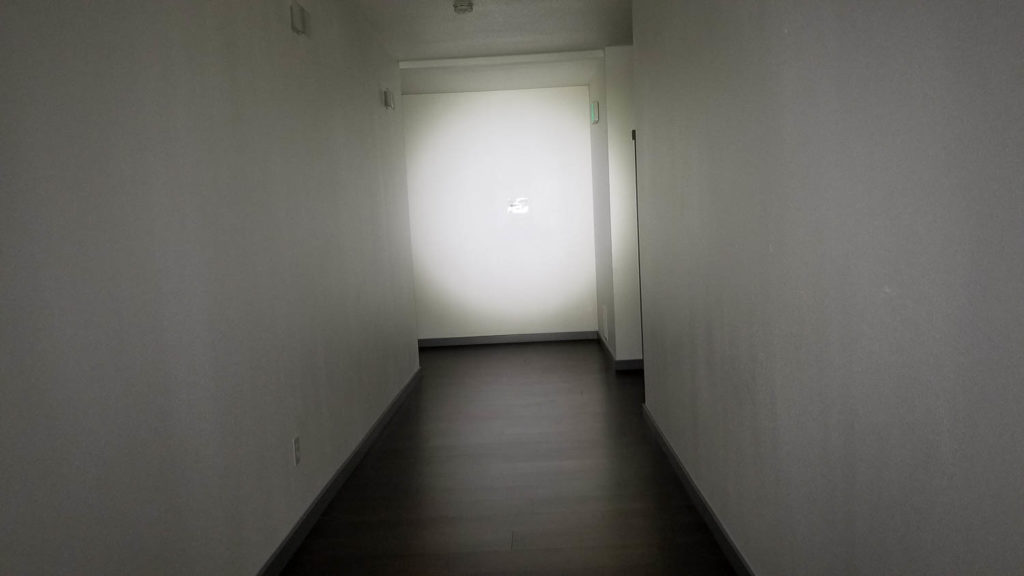



Disclaimer: This flashlight was sent to me for review at no cost by Fenixlighting. I have not been paid to review, nor have I been holding back on problems or defects.
Explanation on star ratings:
- – Avoid: my phone flashlight would be a better choice
- – Poor: significant defect or issues, much better options available at the same price
- – Average: some defects or issues
- – Good: recommended (minor issues)
- – Great: highly recommended
Final Verdict
Pros
- Fantastic build quality
- Simple, effective UI
- 2-button configuration works great
- Consistent performance with long runtimes
- Versatile and effective beam
- Carbide breaking tips
- Non-proprietary battery
Cons
- Green tint in low modes
- Didn’t meet lumen rating on turbo

5 stars: ★★★★★
Fenix has been in the flashlight business a long time, and it shows in the quality, design, and functionality of the Fenix TK16 V2.0. The goal of a 2nd release or refresh of an existing model is to obviously make it better, and Fenix has done that. It’s easy to stick some gimmicky and useless features on a standard light, paint or anodize it black and call it “tactical,” but there’s a big difference between those and a true tactical flashlight meant for professional duties like the TK16 V2.0. Moreover, Fenix stands behind their product with an awesome warranty.
Although there are other professional-grade brands out there, I’d have no qualms about giving this to a police officer, security guard, paramedic, firefighter, or other professional who needs a solid, high performance, and reliable flashlight. I really like the design (the breaking tips are great),and the dual-switches are properly implemented.
The UI is simple and would be easy for anyone to quickly master. The SST70 is a great choice for this light and gives a great balance of output, side illumination, and good throw. It’s perfectly matched to the driver and gives fantastic runtime and consistency.
The only nitpicky thing is the tint is a little green, but that’s common to the SST70, and the lumens were down a bit, but I can look past that since it’s still very bright, throws great, and I can use non-proprietary batteries in it. Fenix has delivered a great performing and high-quality light that proudly carries on the TK16 nameplate. 5 stars all the way.
Fenix TK16 discount code
Get 10% off every purchase at Fenix Lighting US, by using our exclusive 1lumen discount code: 1lumen10
1lumen selects and reviews products personally. We may earn affiliate commissions through our links, which help support our testing.